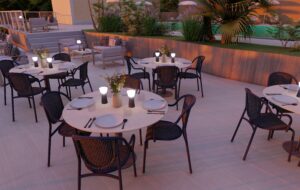|
|
||
|
Blue is the colour of post-disaster landscapes, of the plastic sheets that offer protection and improvised shelter. But from Rwanda to New Orleans, the tarp has also come to symbolise the absence of longer-term solutions Why blue? Blue to cover firewood or motorcycles in the yard, to protect sports fields during rainstorms, or to wrap a truckload of furniture, untied edges flapping like shards of sky. Blue to convey your purchases from Ikea, to lay out your gear on wet ground, to wrap delicate plants before a hard freeze. Blue to shelter thousands who have lost their homes. The economies of do-it-yourself and of disaster relief mesh along the flexible, but short-lived, weave of blue tarps. Blue denotes cheap. Tarp producers follow an informal, though chromatically charged, rating spectrum, from light-duty blue to green to silver to super-heavy-duty brown. Here in Florida, with seven dollars, I can buy Home Depot’s “sky blue” 10ft by 12ft tarp, a size halfway to the standard-issue blue plastic sheeting used by the US’s Federal Emergency Management Agency. Tarps are made from polyethylene, laminated in three layers. Since the 1970s, a woven core sheet has served as a “rip stop”, which in blue tarps is typically eight strands per inch of warp and weft. Their total thickness is only five thousandths of an inch – plastic with the thinness of a paper bag. Blue tarps have come to symbolise transience and need. Tarps are not tents; their ephemerality is in stark contrast to the protracted relief efforts and enduring media images that infuse our global conscience with the blue tints of homeless encampments in Tokyo and Seattle, post-earthquake schools in Pakistan, refugee camps in Rwanda, and the post-disaster settlements that remain in place five years after Haiti’s 7.0 magnitude earthquake. Tarp is short for tarpaulin, a word that sounds out its origins in tar and pall, and recalls the tarred black canvases used to cover objects on ships, their colour suggestive of a funerary pall. In contrast, today’s bright blue is an all-too-cheerful shroud over post-disaster landscapes. Blue is not an abundant colour in terrestrial landscapes, allowing aerial media reports to measure damage or hardship by blue wounds. Blue tarps successfully convey short-term assistance but point towards failures in longer-term shelter and protection. Which is to say that visibility is inversely related to durability. So goes the logic of post-disaster economics. And blue now indicates life after disaster. The hot blue light of improvised shelters. Psychologists tell us that blue invokes trust, it instils calm, affecting us mentally rather than physically. But in the harsh world of post-disaster relief, is this enough? In the wake of Hurricane Katrina, we were left with so many blue after-images: FEMA’s “operation blue roof”, Florida’s “blue tarp cities”, the “blue tarp tours” of competing politicians who condemned higher insurance rates and “blue tarp blues” sung by New Orleans’s journalists, bloggers and folk musicians. Festival-goers wore blue tarp clothing for Mardi Gras parades the following year. And Antoine’s Restaurant hosted a fundraiser requiring fashion designers to integrate blue tarps into their entries. This activation of the blue tarp’s iconography makes use of the camp’s material as a performative “camp”. It links symbolism to need and just might help us rethink how we make camp. |
Words Charlie Hailey |
|
|
||




















